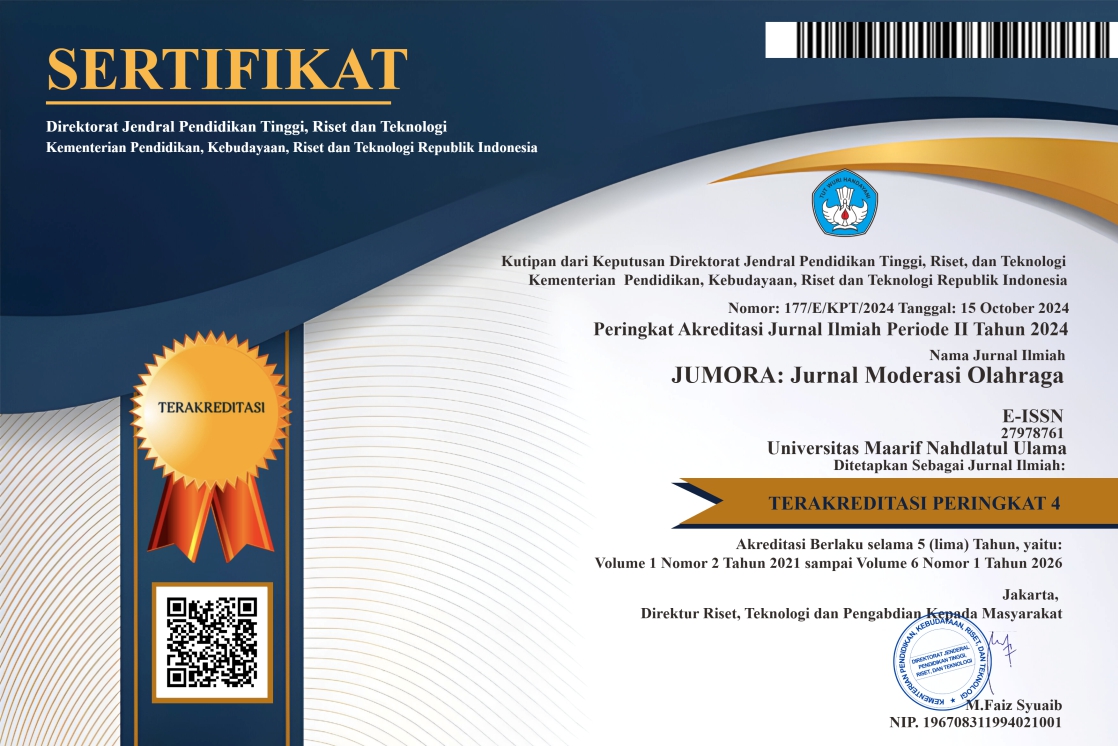Olympic Movement Based Pencak Silat Training Model Block and Random Methods
DOI:
https://doi.org/10.53863/mor.v5i1.1536Keywords:
Pencak Silat, valuesolympic movement, ValuesAbstract
The crisis in value education in sport is increasingly evident, with many athletes prioritizing winning over the application of Olympic values. The paradigm shift from merely pursuing “sporting results” to “growing social impact” is the basis for understanding the importance of sport as a means of social development and improving the quality of life of the community. This research offers a new approach by integrating an Olympic Movement-based pencak silat training model, so that fighters/athletes gain a more comprehensive understanding of Olympic Movement values. This study used an experimental method with 45 participants divided into three groups: 15 participants in the Olympic Movement-based pencak silat training block method group, 15 participants in the random method group, and 15 participants in the control group. The instrument used was the Olympic Movement Instrument (OMI). The results showed a difference in the effect on the understanding of Olympic Movement values in each group. The group that practiced using the Olympic Movement-based model with block and random methods showed better results than the group that did not use the model. In conclusion, the Olympic Movement based pencak silat model that emphasizes the values of respect, friendship, and excellence with a deliberate structure has proven effective in improving understanding of Olympic Movement values and shaping the character of fighters. This model is considered feasible to use in athlete development
References
Astle, D. E., Bathelt, J., & Holmes, J. (2019). Remapping the cognitive and neural profiles of children who struggle at school. Developmental Science, 22(1), e12747. https://doi.org/10.1111/desc.12747
Bean, C., K. K. & F. T. (2016). Moving beyond the gym: Exploring life skill transfer within a female physical activity-based life skills program. Journal of Applied Sport Psychology.
Davies, F., & Tsiantas, G. (2008). Olympic sponsorship: evolution, challenges and impact on the Olympic Movement. International Journal of Sports Marketing and Sponsorship, 9(4). https://doi.org/10.1108/ijsms-09-04-2008-b006
Doll-Tepper, G. (2008). Sport and Olympism: Common issues, threats and opportunities analysed by academic research Working Document President International Council of Sport Science and Physical Education (ICSSPE).
Flindall, R., & Wassong, S. (2017). More than a festival: Analysing opinion-forming sports journalists’ perceptions of olympism and the olympic movement. South African Journal for Research in Sport, Physical Education and Recreation, 39(Specialedition1-2).
Ford, P., De Ste Croix, M., Lloyd, R., Meyers, R., Moosavi, M., Oliver, J., Till, K., & Williams, C. (2011). The Long-Term Athlete Development model: Physiological evidence and application. Journal of Sports Sciences, 29(4), 389–402. https://doi.org/10.1080/02640414.2010.536849
Fraenkel, Jack R., Wallen, N. E. (2022). How to Design and Evaluate Research in Education. In McGraw-Hill Higher Education (11th ed.). https://www.libgen.is/book/index.php?md5=BF7C0575E403691A9E8C8654BD9717FD
Ha, J. P., Lee, K., & Ok, G. (2015). From Development of Sport to Development through Sport: A Paradigm Shift for Sport Development in South Korea. International Journal of the History of Sport, 32(10), 1262–1278. https://doi.org/10.1080/09523367.2015.1062756
Hambali, S., Sundara, C., & Meirizal, Y. (2020). KONDISI FISIK ATLET PENCAK SILAT PPLP JAWA BARAT. Multilateral Jurnal Pendidikan Jasmani Dan Olahraga, 19(1). https://doi.org/10.20527/multilateral.v19i1.8217
Ihsan, N., Ser, I. O. P., Sci, G., Iop, K., & Ilmu, S. (2017). Pengembangan Sistem Pengukuran Kecepatan Tendangan Pencak Silat Berbasis Teknologi Sensor Pengembangan Sistem Pengukuran Kecepatan Tendangan Pencak Silat Berbasis Teknologi Sensor. 0–8.
Johansyah L. (2014). Pencak Silat Edisi Pertama. Jakarta: PT Raja Grapindo.
Kartomi, M. (2011). Traditional and modern forms of pencak silat in Indonesia: The suku mamak in Riau. Musicology Australia, 33(1), 47–68. https://doi.org/10.1080/08145857.2011.580716
Kendellen, K., Camiré, M., Bean, C. N., Forneris, T., & Thompson, J. (2017). Integrating life skills into Golf Canada’s youth programs: Insights into a successfulresearch to practice partnership. Journal of Sport Psychology in Action, 8(1), 34–46. https://doi.org/10.1080/21520704.2016.1205699
Kidd, B. (n.d.). Sport for development and the Olympic Movement.
Kidd, B. (2008). A new social movement: Sport for development and peace. In Sport in Society (Vol. 11, Issue 4, pp. 370–380). https://doi.org/10.1080/17430430802019268
Kidd, B. (2013). The Olympic Movement and the sports-media complex. Sport in Society, 16(4), 439–448. https://doi.org/10.1080/17430437.2013.785754
Koenigstorfer, J., & Preuss, H. (2018). Perceived Values in relation to the Olympic Games: development and use of the Olympic Value Scale. European Sport Management Quarterly, 18(5), 607–632. https://doi.org/10.1080/16184742.2018.1446995
Legault, L. (2017). Self-Determination Theory. In Encyclopedia of Personality and Individual Differences (pp. 1–9). Springer International Publishing. https://doi.org/10.1007/978-3-319-28099-8_1162-1
Liu, Y. (2016a). The development of social media and its impact on the intercultural exchange of the Olympic movement, 2004–2012. International Journal of the History of Sport, 33(12), 1395–1410. https://doi.org/10.1080/09523367.2017.1285285
Liu, Y. (2016b). The development of social media and its impact on the intercultural exchange of the Olympic movement, 2004–2012. International Journal of the History of Sport, 33(12), 1395–1410. https://doi.org/10.1080/09523367.2017.1285285
Ma’mun, A. (2019). Governmental Roles in Indonesian Sport Policy: From Past to Present. International Journal of the History of Sport, 36(4–5), 388–406. https://doi.org/10.1080/09523367.2019.1618837
Muhtar, T. (2020). Pencak silat - Google Books. https://www.google.co.id/books/edition/Pencak_silat/vGvoDwAAQBAJ?hl=id&gbpv=1&dq=pencak+silat&printsec=frontcover
Mulyana. (2013). Pendidikan Pencak Silat. Bandung: PT Remaja Rosdakarya. In 2013.
Mulyana, B., & Lutan, R. (2021). The Lost Inner Beauty in Martial Arts: A Pencak Silat Case. International Journal of the History of Sport, 37(12), 1172–1186. https://doi.org/10.1080/09523367.2020.1742703
Pendidikan, F., Alicante, U., Olimpiade, A., Direktur, S., Studi, P., & Universitas, O. (2010). Jurnal Olahraga dan Latihan Manusia on line. V(I), 3–14.
Peres, F. de F., de Melo, V. A., & Knijnik, J. (2016). Olympics, media and politics: The first Olympic ideas in Brazilian society during the late nineteenth and early twentieth centuries. International Journal of the History of Sport, 33(12), 1380–1394. https://doi.org/10.1080/09523367.2016.1275578
Putra, J. P., Kusmaedi, N., Mulyana, M., & Ma’mun, A. (2023). Effect of Limb Power, Arm Power, Hand Eye Coordination on the Combination of Punches and Kicks of Martial Arts Athletes. Month, 3(1). https://doi.org/10.53863/mor.v0i00
Real, M. R. (1996). The Postmodern Olympics: Technology and the Commodification of the Olympic Movement. Quest, 48(1), 9–24. https://doi.org/10.1080/00336297.1996.10484175
SAMARANCH, J. A. (1995). The Olympic Movement. Journal of International Communication, 2(1), 3–5. https://doi.org/10.1080/13216597.1995.9751798
Shihab, M., & Musiasa, N. (2017). Strategi Public Relations dan Pencak Silat Tradisional. Jurnal Ilmu Sosial Dan Ilmu Politik, 6(1).
Siljak, V., & Djurovic, D. (2017a). Historical development of the olympic movement. Sport Mont, 15(3), 43–46. https://doi.org/10.26773/smj.2017.10.008
Siljak, V., & Djurovic, D. (2017b). Historical development of the olympic movement. Sport Mont, 15(3), 43–46. https://doi.org/10.26773/smj.2017.10.008
Somphong, S., Kutintara, I., & Rattamanee, K. (2019). The impact of the Thailand Olympic Academy on the Olympic Movement in Thailand. African Journal of Hospitality, Tourism and Leisure, 8(2).
Soo, J., Woods, C. T., Arjunan, S. P., Aziz, A. R., & Ihsan, M. (2018). Identifying the performance characteristics explanatory of fight outcome in elite Pencak Silat matches. International Journal of Performance Analysis in Sport, 18(6), 973–985. https://doi.org/10.1080/24748668.2018.1539381
Spaaij, R. (2012a). Olympic rings of peace? The Olympic movement, peacemaking and intercultural understanding. Sport in Society, 15(6), 761–774. https://doi.org/10.1080/17430437.2012.708279
Spaaij, R. (2012b). Olympic rings of peace? The Olympic movement, peacemaking and intercultural understanding. Sport in Society, 15(6), 761–774. https://doi.org/10.1080/17430437.2012.708279
Subekti, N., Sistiasih, V. S., Syaukani, A. A., & Fatoni, M. (2020). Kicking ability in pencak silat, reviewed from eye-foot coordination, speed, and ratio of limb length-body height. Journal of Human Sport and Exercise, 15(Proc2), 453–461. https://doi.org/10.14198/jhse.2020.15.Proc2.36
Suwirman. (2011). Teknik Dasar Pencak Silat. Padang Fakultas Ilmu Keolahragaan Universitas Negeri Padang. .2012 Statistika untuk Penelitian. Bandung: Alfabeta.
Syafruddin. (2011). Ilmu Kepelatihan Olahraga. Padang: UNP Press.
Syaifullah, R., & Doewes, R. I. (2020). Pencak silat talent test development. International Journal of Human Movement and Sports Sciences, 8(6), 361–368. https://doi.org/10.13189/saj.2020.080607
UU Keolahragaan 2022. (n.d.).
Whitley, M. A., Forneris, T., & Barker, B. (2014). The Reality of Evaluating Community-Based Sport and Physical Activity Programs to Enhance the Development of Underserved Youth: Challenges and Potential Strategies. Quest, 66(2). https://doi.org/10.1080/00336297.2013.872043
Ha, J. P., Lee, K., & Ok, G. (2015). From Development of Sport to Development through Sport: A Paradigm Shift for Sport Development in South Korea. International Journal of the History of Sport, 32(10), 1262–1278. https://doi.org/10.1080/09523367.2015.1062756
Koenigstorfer, J., & Preuss, H. (2018). Perceived Values in relation to the Olympic Games: development and use of the Olympic Value Scale. European Sport Management Quarterly, 18(5), 607–632. https://doi.org/10.1080/16184742.2018.1446995
Sugiyono. (2015). Metode Penelitian Pendidikan (pendekatan Kuantitatif. Kualitatif, dan R & D). Bandung Alfabeta.
Umbara, U., Munir, M., Susilana, R., & Puadi, E. F. W. (2019). Increase Representation in Mathematics Classes: Effects of Computer Assisted Instruction Development with Hippo Animator. International Electronic Journal of Mathematics Education, 15(2). https://doi.org/10.29333/iejme/6262
Downloads
Published
How to Cite
Issue
Section
License
Copyright (c) 2025 Jeki Purnama Putra, Puji Astuti, Krisno Giovanni, Oki Candra, Resty Gustiawati

This work is licensed under a Creative Commons Attribution-ShareAlike 4.0 International License.
Authors retain copyright and grant the journal right of first publication with the work simultaneously licensed under a Creative Commons Attribution-ShareAlike 4.0 International License that allows others to share the work with an acknowledgment of the work’s authorship and initial publication in this journal











